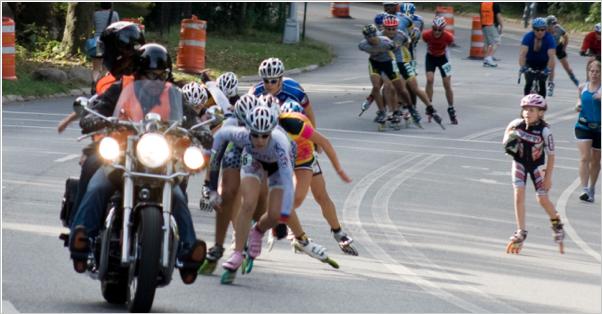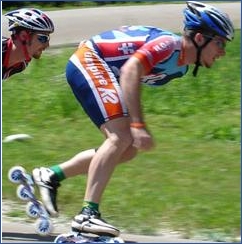This week's tip:
Taking It Outdoors
How to go from indoor to outdoor skating

Action you won't want to miss at the NY100K.
(photo: John Williams)
By Peter Doucet
Indoor skating is a great way to develop your skills. It builds technique, fitness, power, agility and tactical awareness.
But I have to tell you this: some of the greatest experiences in skating happen outdoors — the World Inline Cup, the Northshore Inline Marathon, the Montreal 24h relay — and above all else, the simple joy of skating on a beautiful day in the open air.
If you are an experienced indoor skater, you already have most of the skills you need to succeed outdoors. But there is a bit of a learning curve.
Here’s some things to keep in mind as you develop your “outdoor legs:”
Shins can burn
Indoors, you skate on nice smooth surfaces: smooth floors of wood, cement or terrazzo. Outdoors, you skate on not-so-smooth surfaces: roads or trails of asphalt or less than perfect cement.
The rougher surface can play havoc with your shins. It causes vibration to move up through your legs, and at times, on a really rough road, it can feel like someone is beating on your shins with a stick.
Ouch!
But this doesn’t last. You can prevent sore shins — or at least get used to them — by regularly training outdoors on rough surfaces. I’ve found that you can get used to almost any skating surface if you train on it regularly.
Another thing you can do on rough roads is use softer wheels, which will absorb more “road noise.”
Moving faster
Outdoor skaters aren’t necessarily faster than indoor skaters — but they go faster. That’s because outdoor skating has lots of straightaways, fewer corners and occasional downhills — all of which facilitate speed.
At higher speeds, your skates track differently. That means you have to change the speed and angle of your push.
Not to worry!
Again, the solution is to train outdoors — at speed, and preferably with other skaters.
Equipment
Indoor skates are the same as outdoor skates. But you’ll want to make a few changes. For starters, don’t use your indoor wheels outdoors. Indoor wheels are too hard for outdoor skating. They will pick up too much road vibrations and won’t grip on tight turns.
Find yourself some good outdoor wheels. There are plenty of great choices. And be prepared to replace wheels regularly. Asphalt is a lot harder on urethane than coated floors.
Maintenance
Skating indoors, you often develop big clumps of hair wrapped around your axles. That’s not a problem outdoors. Instead, you get gunk: dust, oil and grime coating your bearings and frames.
Again, not a serious problem. Just wipe it off with a rag when you rotate or change your wheels.
Need for speed
Indoor skaters compress their bodies (get low) in the corners. And since they are usually in the corners, they spend a lot of time in the low position.
On the other hand, outdoor skaters spend more time on straightaways and drafting in pacelines. Sometimes, they are going fast. Sometimes, they are standing up.
For outdoor skaters, the key is to be able to generate “straight-line speed.” This is the speed you need to accelerate with breakaways and vie for medals in the field sprints.
If you are not sure about how to generate straight-line speed, read Bill Begg’s guide: Six Steps to Straight-line Speed.
Know the rules
Outdoor skating has its own rules, which can vary from race to race. Read the event rulebook before you reach the starting line. A couple things you should check on is whether cross-drafting is allowed between the sexes and the divisions.
Weather or not
One of the great advantages of indoor skating is the consistent conditions.
One of the great advantages of outdoor skating is the opposite: the endless variety.
No two races — even on the same course — is the same. Outdoor skaters talk about the year there was ice at the Northshore or the year it snowed at the Montreal Inline Marathon. Every event is different and that adds to the endless challenge and excitement of the sport.
Be ready for whatever!
Pack layers so you are ready to go if the the weather turns north. Bring rain wheels for the wet, and a water bottle for the hot.
Hills
Most outdoor races, especially marathons, have at least a few hills. So get used to them.
Climbing forces you to adjust your technique. Some skaters climb with their chest up. Others push back more with their wheels and stroke faster.
Find a technique that suits your size and ability. And make sure you are also comfortable skating down hills. This is usually accomplished in a sturdy tuck with the wheels shoulder width apart.
Debris
Keep a lookout for rocks, twigs and whatever else — dead skunks? — that might appear on the roadway. Tar snakes — cracks that have been filled with tar — are especially dangerous. They grab your wheels.
Other hazards include sand, gravel and pine needles.
If you are in a paceline, keep checking ahead for obstacles. And as a courtesy to fellow pack skaters, point out dangerous conditions you see.
...
 Peter Doucet is an indoor and outdoor skater and the winner of the 2010 National Roller Cup. A resident of Mississauga, Ontario, he has represented Canada in seven World Championships and at the 2007 Pan American Games in Brazil. He founded the Toronto International Inline Race Weekend and the RSO Speed Points Series. He is also a coach of the Toronto Inline Skating Club and webmaster of Speed Skate World. His hobbies include writing and performing music, cycling, watching movies, going out with friends, and cooking.
Peter Doucet is an indoor and outdoor skater and the winner of the 2010 National Roller Cup. A resident of Mississauga, Ontario, he has represented Canada in seven World Championships and at the 2007 Pan American Games in Brazil. He founded the Toronto International Inline Race Weekend and the RSO Speed Points Series. He is also a coach of the Toronto Inline Skating Club and webmaster of Speed Skate World. His hobbies include writing and performing music, cycling, watching movies, going out with friends, and cooking.